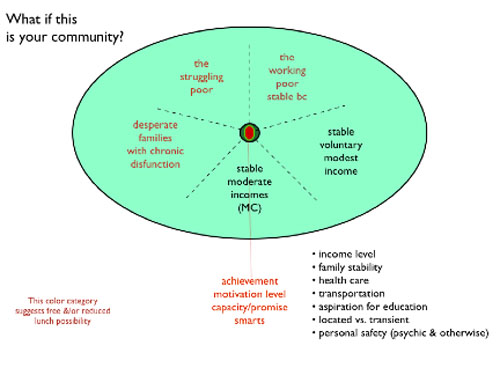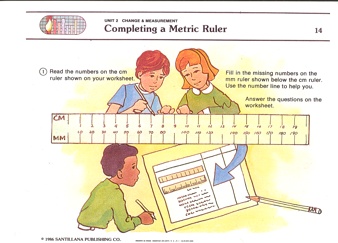What is more beautiful than a crisp winter’s day, blue sky, and a new adventure in life? TOTALLY AWESOME.
Month: February 2006
Thinking about poverty in our schools
This diagram is portion of a piece I do with students on learning as an interactive process. The point I try to make is that student outcomes like achievement, capability, motivational level, and performance (the red arrow coming from a red circle that represents a student at the center of often contending forces in a school) are determined by the context in which the student is educated. A given child may be seen as quite a different student with different levels of achievement, performance and observed levels of motivation in two different schools because of how the context of education in those two places are different.
A recent discussion about levels of poverty has got me thinking about deconstructing free and reduced lunch count, our profession’s proxy for poverty. The school community (light green circle) is made up of several groups of families. Three sets of families, those represented by reddish print, might identify as frl qualified. In terms of data crunching the relationships between poverty and achievement, all three categories of families collapse into one number. In fact, one category of family, the desperate family group, is the category most at risk for acquiring achievement gains in school. Their lives are so chaotic to meet basic needs (transportation, safety, etc. – the needs represented in black print ) that learning in school is compromised day after day.
As a district’s overall level of poverty rises, I suspect the number of families experiencing the most debilitating effects of poverty also rises. As the level of poverty rises, the schools and its teachers are called upon to provide much more support just to get their children to the point where they can focus and pay attention. Teaching time decreases. Performance suffers. Rates of academic engagement – talking and working together on academic tasks – drops.
What if we re-focused our free and/or reduced lunch count proxy for poverty to look at poverty through several lenses? What effect would this have on decisions we made about schooling? About teaching and learning processes? I would hope this diagram might serve to clarify thinking on the matter.

I also have to say that as Washington continues to exact resources from school and community programs, as Washington continues to consolidate and shift resources to state decision makers, as Washington continues to fund those who fail to see the relationship between community support and civil behavior, the situations facing schools continue to worsen. The basketball hoops in church yards have disappeared. The community training programs have dried up. The youth work jobs are no more. The federal government has turned its back on its most vulnerable and decreasingly hopeful people. Instead, we build more jails to house those we have left behind.
Excellence in licensure-based teacher education programs: criteria and support.
I want to use this entry to (1) name my criteria for what constitutes excellence in teacher education programs; and, (2) I want to use this entry to collect research evidence that the criteria I mention define excellence.
For purposes of this entry, I am defining excellence in this way. “Excellence” means that program assessments document that students in the program (“candidates”) learn to teach in ways that create significant gains in content achievement by their public school students. I do not stipulate my definition of “Excellence” to be solely about a particular value position or set of practices. “Excellence” in my book occurs when candidates show they can “do the job.” In this case, this means understanding how classroom social and instructional structures interact to form a climate for learning. “Excellence” means that candidates for licensure must provide evidence that all their students have learned at higher than normal rates because of how they have been taught by the candidate.
Any one reading is welcome to comment, suggest criteria, add research citations. For the time being, the kinds of programs I am targeting are undergraduate programs that lead to a baccalaureate degree and full eligibility for at least an entry level teaching license, K-6 endorsement.
Criteria One: Significant program experiences are situated in actual classrooms in a public school and supervised in part by university faculty named as teaching faculty.
situated
supervised
supervised by responsible faculty
Criteria Two: Methods courses require actual application and analysis in field based settings and reflect alignments between content, instruction, assessment, learner requirements, and appropriate standards frameworks.
methods learnings field tested
content/instruction/assessment/learner need aligned and analyzed
content is important content (standards informed)
Criteria Three: Teacher education students are taught knowledgeably relative to their career position. That is, their own learning environments reflect an appropriate dissonance between immediate need and more complicated instructional goals. Learning to teach is as much learning how to think about contextually sensitive teaching learning goals and objectives as it is about learning the specific tasks, tools, and methods of teaching.
continuum of pedagogical expertise
matching teaching and learning environments
tasks, tools, and methods
context sensitive and context free instruction
Criteria Four: Teacher education coursework and practica require successful completion of required outcomes with school populations that differ by age (at least three years apart) and culture; evaluated candidate reflection regarding their knowledge, skill, and ability to work with different cultures of students; and, successful evaluations of required outcomes by the appropriate cultural representatives. This criteria requires that candidates identify as multicultural individuals.
instructional experience with different age groups
instruction experience with different student cultures
multicultural identity
Criteria Five: Each faculty member of the teacher education program identify as a multicultural individual, have assigned responsibilities in both field and campus based instruction, and regularly process their position as a multicultural teacher with professional groups that go beyond sole dominant culture membership.
balanced campus/field responsibilities
professional reflection relative to multicultural identities
Criteria Six: Candidates and faculty are individually accountable for documenting successful program completion through the use of appropriate web-based technology systems.
use of web-based assessment systems
personal accountability
Criteria Seven: Candidates will demonstrate program defined levels of competence in interdisciplinary teaching methods, assessment driven instruction, differentiation of instruction, inquiry based teaching, complex instruction cooperative learning, and inclusive practice.
interdisciplinary teaching
assessment driven instruction
inquiry based teaching
complex instruction
inclusive practices tailored for students receiving additional school based services
differentiation

